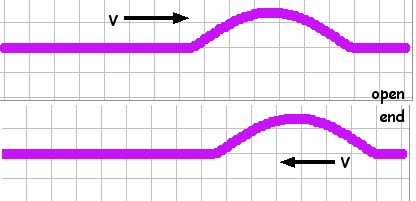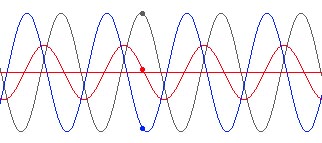| propogation |
Waves don't move or travel - they propogate.
In mechanical waves, the medium is displaced from equilibrium as the wave passes, but the medium returns to equilibrium after the wave is gone. There is no net motion of the medium while the wave propogates from one place to another.
|
absorption
(vs damping) |
As a wave propogates through a medium some of its energy can be lost within the medium. These might be frictional forces. How will you know that energy is being lost in a mechanical wave? ( gnisearced si edutilpma)
Damping is when an outside force takes the wave energy. shock absorbers on a car produce damping
|
| reflection and refraction |
The boundary between two media is called the interface.
When wave energy reaches the interface some of the wave energy will stay
in the first medium and some will propogate into the second medium. The
wave that stays within the first medium is called the reflected wave.
The wave that moves into the second medium is called the refracted wave.
The greater the difference in the velocity of the two waves the more energy
that is reflected. If v1 > v2 then the reflected
wave will have a phase shift of 180° (f
= p ; completely out of phase) compared tothe
original wave (called the incident wave). If v1 < v2
then the reflected wave will have a phase shift of 0°, and the reflected
wave and the incident wave will be in phase.
reflection
applet
|
interference |
When two or more waves are at the same point in a medium
at the same time they interfere with each other. If a crest meets a crest
(a crest is superimposing on another crest) the interference is said to
be constructive where the result is a "super crest". If
a crest meets a trough the intereference is called destructive where
the result is a node.
Christian Huygens gave a formal explanation using Huygens' Principle of Superposition that said that when two waves superimpose on each other (are at the same place in the medium at the same time) the resulting wave's amplitude is the algebraic sum of the individual amplitudes. If two waves interefere and have amplitudes of 2 cm and 3 cm then the resulting wave will have an amplitude of 5 cm (constructive intereference). If the two interfering waves have an amplitude of 3 cm and -2 cm the resulting wave will have an amplitude of 1 cm (destructive interference).
Interference applet
|








